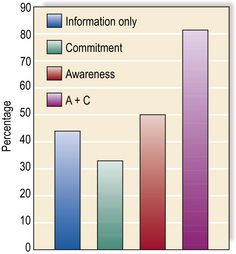Chapter 37 Changing cognitions and behaviour
Often we can change people’s behaviour by changing their environment. For example, making condoms, dental care or medication easy to access and inexpensive is crucial to health promotion. Similarly, banning smoking in public places is likely to be more effective in reducing smoking and its health impact than individual smoking cessation programmes (Sargent et al., 2004).
Contradictions and change
An experiment by Stone et al. (1994) shows the relevance of cognitive dissonance theory to health promotion. In this study participants were randomly allocated to four conditions: (1) receiving information about condom use (information only); (2) receiving information and giving a talk promoting condom use that might be used in health education in schools (commitment); (3) being made aware of past failures to use condoms by recalling these failures (awareness), and (4) a combination of the commitment and awareness conditions. All participants were then given an opportunity to buy condoms. Figure 1 shows that generating commitment and making participants aware of their own past failures led to greater condom purchase than the other three strategies. Participants in the combined condition (4) would have found it difficult to change the belief that condom use was worthwhile, because they had been persuaded to promote the importance of condom use. Yet they could not change their awareness of their own past failures to use condoms. In these circumstances, cognitive dissonance theory predicts that they would seek to reduce their cognitive dissonance by distancing themselves from their past failures. Affirming the intention to use condoms in the future, and regarding themselves as different from the person who failed to use condoms in the past, resolves the cognitive contradiction created by the ‘awareness’ condition. Hence many more people in this commitment and awareness group (82% versus 50% in the awareness condition) took the opportunity to buy condoms. This study also emphasizes that providing people with information alone may not be enough to motivate them to take action (only 44% bought condoms in the information-only condition).
Stay updated, free articles. Join our Telegram channel

Full access? Get Clinical Tree



